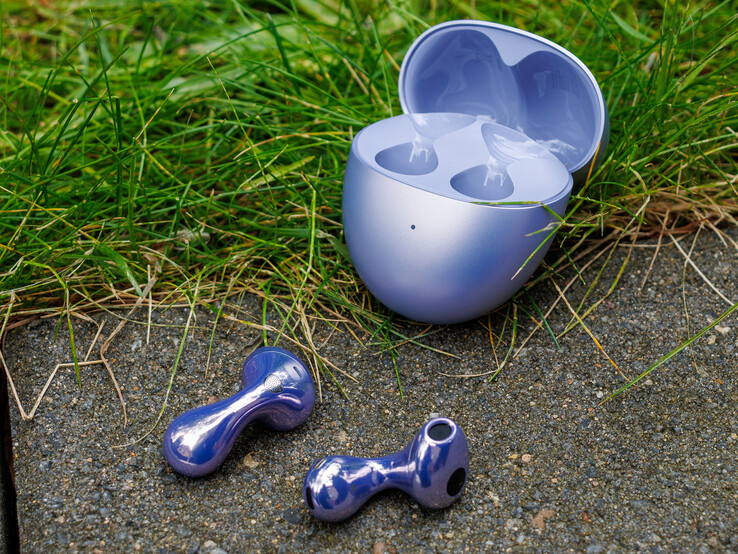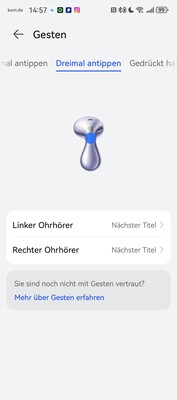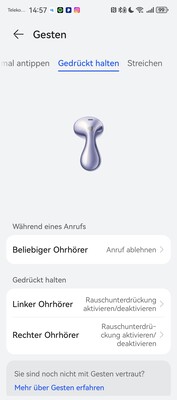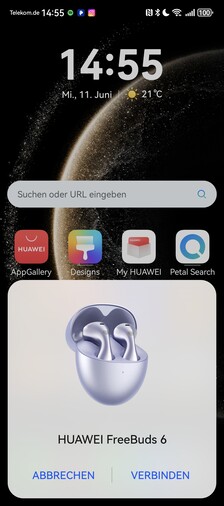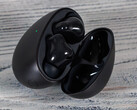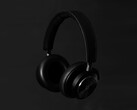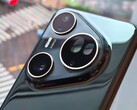Verdict - limitations outside the Huawei cosmos
The latest Huawei FreeBuds once again rely on an organic open-fit design. The product is protected against dust and splashes of water in accordance with IP54. Technically, the FreeBuds 6 support HD audio, dual Bluetooth (multipoint) and can be controlled via touch gestures and an app.
In terms of their sound, the FreeBuds offer an extended frequency range up to 48,000 Hz and an overall balanced, slightly treble-emphasized sound quality. ANC is only effective to a limited extent, but it does reduce background sounds without producing any noise in quiet environments. The microphone quality for phone calls is average and sometimes sounds a bit muffled.
Certain functions, such as lossless audio (L2HC 4.0), room audio and microphone recording, are unfortunately reserved for Huawei devices (from EMUI 15).
Pros
Cons
Specifications
| Type | open in-ears / open-fit |
| Connectivity | Bluetooth 5.2 |
| Reach | 10 m |
| Speakers | dynamic 11-mm drivers + UHF flat membrane drivers, 14 - 48,000 Hz |
| Audio codecs | SBC, AAC, LDAC, L2HC 4.0 |
| Battery | 39.5 mAh (per earbud), 510 mAh (charging case) |
| Charging connection | USB-C |
| Wireless charging | yes |
| Weight | 4.9 g (per earbud), 40.3 g (charging case) |
| Firmware version | HarmonyOS 5.0.0.258 |
| Scope of delivery | 1 pair of earphones, charging case, USB-C charging cable |
| Price (MRSP - Germany) | 159 euros |
The Huawei FreeBuds 6 are the successor to the FreeBuds 5 and are once again characterized by their exceptional design and wide range of functions.
Despite their open-fit design, they also feature active noise cancellation. The headphones additionally aim to impress with first-class sound, making them a strong competitor to the Apple AirPods 4 ANC.
Case and ergonomics - The FreeBuds 6 are IP54 certified
The Huawei headphones are visually very similar to their predecessor, the FreeBuds 5, and once again feature an organic design. They are available in black, white and purple. Huawei has extended the protection of its TWS headphones to IP54. This means that they are protected against the ingress of dust in harmful quantities and against splashes of water. Again, this only applies to the earphones, but not to the charging case.
The FreeBuds 6 are open-fit headphones, meaning they are not inserted into your ear canal like traditional in-ears, but rather hooked between the tragus and antitragus. The fit is good, but this will probably not be sufficient for sports that require a lot of movement. Ultimately, your own ear shape is the deciding factor.
Sustainability
The Huawei FreeBuds 6 come delivered in compact outer packaging. Although this is made of recyclable paper materials, it is completely shrink-wrapped in plastic.
Huawei hasn't provided any information on its use of recycled materials or the device's CO2e footprint. It also isn't possible to repair the headphones or purchase suitable spare parts.
Connectivity and operation - The FreeBuds 6 master HD spatial audio
Setting up the Huawei FreeBuds 6 is easiest with a Huawei smartphone (min. EMUI 10 or Harmony OS 2.0). It is done automatically via a pop-up, similar to Google Fast Pair. Windows also recognizes the TWS headphones immediately. For other devices, you'll have to pair them manually, but this is done quickly.
The AI Life app, which is available in the Apple App Store and the Huawei AppGallery, is recommended for configuration and updates. Google Android users can download it via the QR code on the headphones' outer packaging or via the Huawei website. The app makes it possible to set wearer detection, perform updates, and adjust the equalizer and ANC. The connection center makes it easy to switch between multiple paired devices. Thanks to dual Bluetooth (Multipoint), two devices can remain connected at the same time.
The FreeBuds 6 can be controlled via a smartphone or by touching the sensor surfaces and can also be used individually. During our test, this worked perfectly and we found that they can be adapted to your own needs in the settings. New features include support for spatial sounds and head gestures, both of which work surprisingly well.
Sound - Lossless audio with L2HC 4.0
Huawei has once again improved the headphones' sound compared to their predecessor. The frequency range has been extended to up to 48,000 Hz and L2HC 4.0 enables an almost loss-free connection via Bluetooth, at up to 2.3 Mbit. The catch: this only works with Huawei smartphones that have EMUI 15 or newer, for example, the Pura 70 Ultra or the Mate X6. Most other Android phones have to make do with LDAC, while Apple products are limited to AAC.
The FreeBuds 6 deliver good sound, but are a little too treble-heavy. During everyday use, however, this is hardly noticeable in a negative way and the sound is balanced, but could be a little more powerful. Nevertheless, the Huawei headphones are best suited for all types of multimedia content.
There is no passive noise cancellation due to their design and the ANC is rather weak. In quieter environments, however, fans or humming noises are audibly muffled. Unlike the FreeBuds 5, the ANC noise is barely perceptible.
In terms of phone calls, the TWS headphones have taken a step back. Although we could understand the person we were talking to very well during our test and background noise was filtered out properly, the user of the FreeBuds 6 often sounded muffled, as if they had a pillow in front of their mouth. Both the FreeArc and the FreeBuds Pro 4 are much better at this.
| Loudspeakers | |
| THD | |
| Huawei FreeBuds 6 (RMS: -2.4 dBFS) | |
| Xiaomi Buds 5 (RMS: -1.9 sBFS) | |
| Apple AirPods 4 ANC (RMS: -2.4 dBFS) | |
| THD+N | |
| Apple AirPods 4 ANC (RMS: -2.4 dBFS) | |
| Xiaomi Buds 5 (RMS: -1.9 sBFS) | |
| Huawei FreeBuds 6 (RMS: -2.4 dBFS) | |
* ... smaller is better
THD (Total Harmonic Distortion): Harmonic distortion quantifies the amount of distortion caused by non-linear distortion (harmonic content) in relation to the original signal. THD only refers to the fundamental component. The distortion factor is often mentioned in the same breath, but refers to the overall signal.
THD+N (Total Harmonic Distortion + Noise): This value is comparable to THD, but in addition to the interference power of the harmonics, that of the noise is recorded as an effective value.
For the measurement, a low harmonic sinusoidal signal (1 kHz, > 0 dB) is played back via the headphones to be tested, which is recorded by a linear measuring microphone (measuring distance: approx. 1 cm) in an artificial head.
Both values are given as a percentage. The lower the value, the better the signal fidelity.
Huawei FreeBuds 6 audio analysis
(+) | speakers can play relatively loud (91.6 dB)
Bass 100 - 315 Hz
(±) | reduced bass - on average 14.3% lower than median
(+) | bass is linear (2.9% delta to prev. frequency)
Mids 400 - 2000 Hz
(±) | reduced mids - on average 7.6% lower than median
(+) | mids are linear (6.4% delta to prev. frequency)
Highs 2 - 16 kHz
(±) | higher highs - on average 11% higher than median
(±) | linearity of highs is average (7.7% delta to prev. frequency)
Overall 100 - 16.000 Hz
(±) | linearity of overall sound is average (20% difference to median)
Compared to same class
» 50% of all tested devices in this class were better, 8% similar, 41% worse
» The best had a delta of 4%, average was 24%, worst was 134%
Compared to all devices tested
» 50% of all tested devices were better, 8% similar, 41% worse
» The best had a delta of 4%, average was 24%, worst was 134%
Apple AirPods 4 ANC audio analysis
(+) | speakers can play relatively loud (92.2 dB)
Bass 100 - 315 Hz
(+) | good bass - only 2% away from median
(+) | bass is linear (2.2% delta to prev. frequency)
Mids 400 - 2000 Hz
(+) | balanced mids - only 1.8% away from median
(+) | mids are linear (1.3% delta to prev. frequency)
Highs 2 - 16 kHz
(+) | balanced highs - only 3.1% away from median
(+) | highs are linear (3.4% delta to prev. frequency)
Overall 100 - 16.000 Hz
(+) | overall sound is linear (6.3% difference to median)
Compared to same class
» 0% of all tested devices in this class were better, 0% similar, 99% worse
» The best had a delta of 4%, average was 24%, worst was 134%
Compared to all devices tested
» 0% of all tested devices were better, 0% similar, 99% worse
» The best had a delta of 4%, average was 24%, worst was 134%
Battery life - Up to 6 hours of playtime
Huawei advertises the FreeBuds 6 with up to 36 hours of battery life. This is with the noise suppression switched off and the additional charge of the case added. With one charge, you should be able to expect up to 6 hours. Listening to music with ANC activated should provide up to 4.5 hours of playtime.
During our battery test with the volume adjusted, the headphones lasted just under five hours. We used an LDAC connection and did without the active noise cancellation. Although this result isn't outstanding, it's still a good value and is an improvement on the predecessor model.
| Battery Runtime - Spotify loop at 65dB/A (incl ANC) | |
| Apple AirPods 4 ANC (AAC, ANC off) | |
| Xiaomi Buds 5 | |
| Huawei FreeBuds 6 (LDAC, ANC off) | |
Transparency
The selection of devices to be reviewed is made by our editorial team. The test sample was given to the author by the manufacturer free of charge for the purposes of review. There was no third-party influence on this review, nor did the manufacturer receive a copy of this review before publication. There was no obligation to publish this review. As an independent media company, Notebookcheck is not subjected to the authority of manufacturers, retailers or publishers.
This is how Notebookcheck is testing
Every year, Notebookcheck independently reviews hundreds of laptops and smartphones using standardized procedures to ensure that all results are comparable. We have continuously developed our test methods for around 20 years and set industry standards in the process. In our test labs, high-quality measuring equipment is utilized by experienced technicians and editors. These tests involve a multi-stage validation process. Our complex rating system is based on hundreds of well-founded measurements and benchmarks, which maintains objectivity. Further information on our test methods can be found here.





